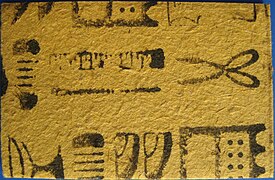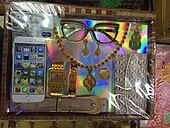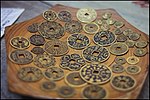
The veneration of the dead, including one's ancestors, is based on love and respect for the deceased. In some cultures, it is related to beliefs that the dead have a continued existence, and may possess the ability to influence the fortune of the living. Some groups venerate their direct, familial ancestors. Certain religious groups, in particular the Eastern Orthodox Churches, Catholic Church and Anglican Church venerate saints as intercessors with God; the latter also believes in prayer for departed souls in Purgatory. Other religious groups, however, consider veneration of the dead to be idolatry and a sin.

Hungry ghost is a term in Buddhism, and Chinese traditional religion, representing beings who are driven by intense emotional needs in an animalistic way. The terms 餓鬼èguǐ literally "hungry ghost", are the Chinese translation of the term preta in Buddhism which is a Sanskrit word. "Hungry ghosts" play a role in Chinese Buddhism and Taoism as well as in Chinese folk religion. The term is not to be confused with the generic term for "ghost" or damnation, 鬼guǐ. The understanding is that all people become such a regular ghost when they die, and would then slowly weaken and eventually die a second time.
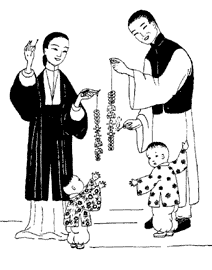
The Qingming Festival or Ching Ming Festival, also known as Tomb-Sweeping Day in English, is a traditional Chinese festival observed by ethnic Chinese in mainland China, Hong Kong, Macau, Taiwan, Malaysia, Singapore, Cambodia, Indonesia, Philippines, Thailand, and Vietnam. A celebration of spring, it falls on the first day of the fifth solar term of the traditional Chinese lunisolar calendar. This makes it the 15th day after the Spring Equinox, either 4, 5 or 6 April in a given year. During Qingming, Chinese families visit the tombs of their ancestors to clean the gravesites and make ritual offerings to their ancestors. Offerings would typically include traditional food dishes and the burning of joss sticks and joss paper. The holiday recognizes the traditional reverence of one's ancestors in Chinese culture.

The Ghost Festival or Hungry Ghost Festival, also known as the Zhongyuan Festival in Taoism and the Yulanpen Festival in Buddhism, is a traditional festival held in certain East and Southeast Asian countries. According to the Chinese calendar, the Ghost Festival is on the 15th night of the seventh month.
Taoism in Singapore is the religion of about 8.8% of the country's entire population as per the 2020 census. The definition of "Taoism" in the country is included as part of the wider Chinese folk religion. In general, nearly all adherents of Taoism in Singapore are associated with the mainstream Zhengyi school. Larger proportion of older residents adhere to Taoism, as compared with those in younger age groups.

Hell money is a modernized form of joss paper printed to resemble legal tender bank notes. The notes are not an official form of recognized currency or legal tender as their sole intended purpose is to be offered as burnt offerings to the deceased as a solution to resolve their assumed monetary problems in the afterlife. This ritual has been practiced by modern Chinese and across East Asia since the late 19th century, and some Wicca-based faiths in recent years have adopted this practice. Early 20th century examples bore resemblance to minor commercial currency of the type issued by businesses across China until the mid-1940s.

A religious goods store, also known as a religious bookstore, religious gifts store or religious supplies shop, is a store specializing in supplying materials used in the practice of a particular religious tradition, such as Buddhism, Taoism, Chinese folk religion, Christianity and Islam among other religions.

A spirit tablet, memorial tablet, or ancestral tablet is a placard that people used to designate the seat of a deity or past ancestor as well as to enclose it. The name of the deity or the past ancestor is usually inscribed onto the tablet. With origins in traditional Chinese culture, the spirit tablet is a common sight in many East Asian countries, where forms of ancestor veneration are practiced. Spirit tablets are traditional ritual objects commonly seen in temples, shrines, and household altars throughout Mainland China and Taiwan.
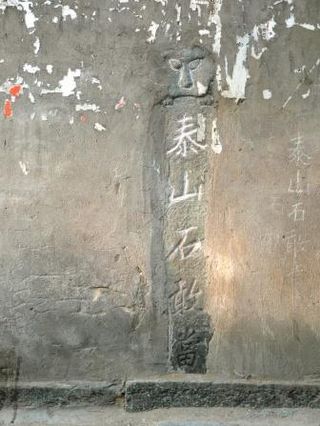
Chinese spiritual world concepts are cultural practices or methods found in Chinese culture. Some fit in the realms of a particular religion, others do not. In general these concepts were uniquely evolved from the Chinese values of filial piety, tacit acknowledgment of the co-existence of the living and the deceased, and the belief in causality and reincarnation, with or without religious overtones.

Jìngxiāng, shàngxiāng, bàishén, is a ritual of offering incense accompanied by tea and or fruits in Chinese traditional religion. In ancestral religious worship it's jìngzǔ or bàizǔ 拜祖. It is observed by a devotee holding joss incense with both hands in front of an altar during the worship. For greater reverence or devotion, the devotee will kneel and bow before the altar during and after placing the incense inside the urn at the altar.

Chinese temple architecture refer to a type of structures used as place of worship of Chinese Buddhism, Taoism, Confucianism, or Chinese folk religion, where people revere ethnic Chinese gods and ancestors. They can be classified as:

Chinese ancestor veneration, also called Chinese ancestor worship, is an aspect of the Chinese traditional religion which revolves around the ritual celebration of the deified ancestors and tutelary deities of people with the same surname organised into lineage societies in ancestral shrines. Ancestors, their ghosts, or spirits, and gods are considered part of "this world". They are neither supernatural nor transcendent in the sense of being beyond nature. The ancestors are humans who have become godly beings, beings who keep their individual identities. For this reason, Chinese religion is founded on veneration of ancestors. Ancestors are believed to be a means of connection to the supreme power of Tian as they are considered embodiments or reproducers of the creative order of Heaven. It is a major aspect of Han Chinese religion, but the custom has also spread to ethnic minority groups.

Chinese folklore features a rich variety of ghosts, monsters, and other supernatural creatures. According to traditional beliefs a ghost is the spirit form of a person who has died. Ghosts are typically malevolent and will cause harm to the living if provoked. Many Chinese folk beliefs about ghosts have been adopted into the mythologies and folklore of neighboring East Asian cultures, notably Japan, Korea, and Vietnam. Beliefs about ghosts are closely associated with Chinese ancestor worship, where much have been incorporated into Buddhism and in turn influenced and created uniquely Chinese Buddhist beliefs about the supernatural.

Benzhuism is the indigenous religion of the Bai people, an ethnic group of Yunnan, China. It consists in the worship of the ngel zex, the Bai word for "patrons" or "lords", rendered as benzhu (本主) in Chinese, that are local gods and deified ancestors of the Bai people. It is very similar to common Chinese religion.

Kev Dab Kev Qhuas is the common ethnic religion of the Miao people, best translated as the "practice of spirituality". The religion is also called Hmongism by a Hmong American church established in 2012 to organize it among Hmong people in the United States.

Chinese folk religion plays a dynamic role in the lives of the overseas Chinese who have settled in the countries of this geographic region, particularly Burmese Chinese, Singaporean Chinese, Malaysian Chinese, Thai Chinese and Hoa. The Indonesian Chinese, by contrast, were forced to adopt en masse either Buddhism or Christianity in the 1950s and 1960s, abandoning traditional worship, due to Indonesia's religious policies which at the time forbade Chinese traditional religion or did not recognize it as a "religion" thus making it vulnerable to discrimination. Some Chinese Filipinos also still practice some Chinese traditional religions, besides Christianity of either Roman Catholicism or Protestantism, of which some have also varyingly syncretized traditional Chinese religious practices with. Chinese folk religion, the ethnic religion of Han Chinese, "Shenism" was especially coined referring to its Southeast Asian expression; another Southeast Asian name for the religion is the Sanskrit expression Satya Dharma.
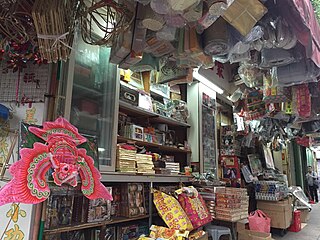
Zhizha, or Taoist paper art, is a type of traditional craft, mainly used as offerings in Taoist festive celebrations and funerals. It had become a widely accepted element in religious practice since Northern Song Dynasty. It now faces a gradual loss of craftsmanship due to related environmental concerns and weakened religious belief.

Traditional papier-mâché offering shops in Hong Kong sell papier-mâché offerings for sacred and festival-celebration purposes. Their popularity has grown since the 1940s. Since the start of the 21st century, demand for sacred papier products has declined, and thus papier-mâché shops and the entire industry is facing a reduction in sales.
A Joss is an English term used to refer to a Chinese deity or idol. It generally describes a Chinese religious statue, object, or idol in many Chinese folk religions.
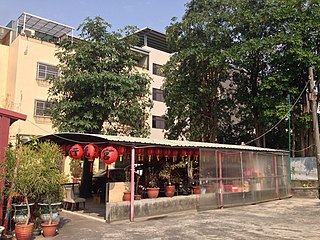
In Taiwanese folk religion, yin miao are temples dedicated to wandering and homeless spirits, as opposed to yang miao, which are dedicated to deities. According to local beliefs, ghosts without a permanent resting place wandering in the human realm and may cause trouble for the living. Therefore, yin miao serve as such resting places for these spirits as a form of respect and to maintain peace. Temples dedicated to deities associated with afterlife, like Cheng Huang Ye or Di Zang Wang, are not considered yin miao.









